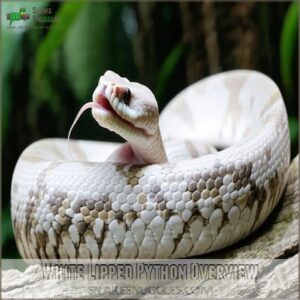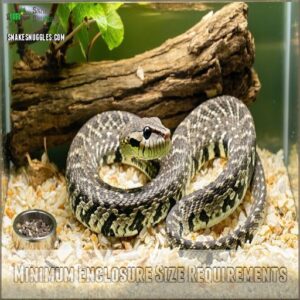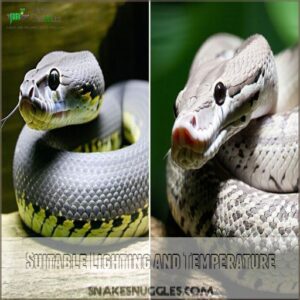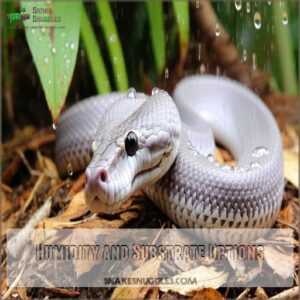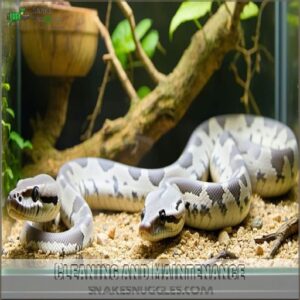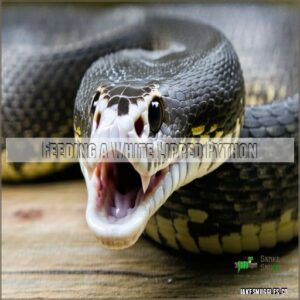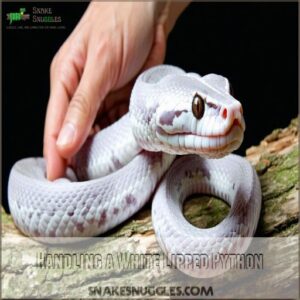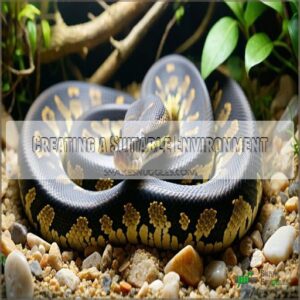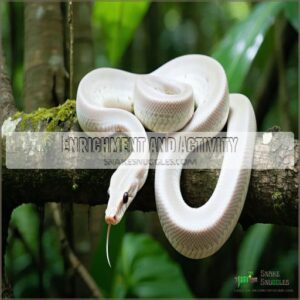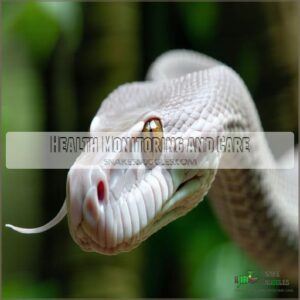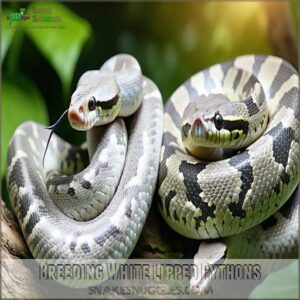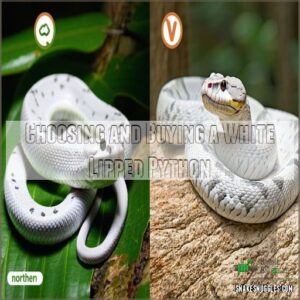This site is supported by our readers. We may earn a commission, at no cost to you, if you purchase through links.
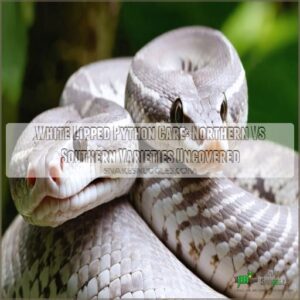
The northern variety, with its striking gold-bronze hue, tends to be smaller, around 7 feet, while the deep brown or black southern variety can exceed 9 feet.
Both thrive in spacious enclosures of at least 48x36x24 inches, with a temperature gradient peaking at 90°F and humidity maintained between 60-80%.
Feed juveniles a mouse weekly, and adults a rat every 10-14 days, ensuring prey matches their girth.
With the right care, your dazzling python will slither happily into its jungly paradise.
Curious about their handling quirks?
Table Of Contents
- Key Takeaways
- White Lipped Python Overview
- Natural Habitat and Distribution
- Housing White Lipped Pythons
- Feeding a White Lipped Python
- Handling a White Lipped Python
- Creating a Suitable Environment
- Enrichment and Activity
- Health Monitoring and Care
- Breeding White Lipped Pythons
- Choosing and Buying a White Lipped Python
- Frequently Asked Questions (FAQs)
- Where do white lipped pythons come from?
- Are white lipped python Hardy?
- Are white lipped pythons right for You?
- What is a northern white lipped python?
- How do you care for a white lipped python?
- What is the difference between northern and southern white lipped pythons?
- What size enclosure for white-lipped python?
- Are white lipped pythons arboreal?
- What is the southern whitelip python?
- How can I provide enrichment for my white lip python in captivity?
- Conclusion
Key Takeaways
- You’ll need a spacious enclosure of at least 48x36x24 inches for your white-lipped python, with temperature gradients peaking at 90°F and humidity levels between 60-80%.
- Both northern (with gold-bronze scales) and southern (with deep brown or black scales) white-lipped pythons require regular feeding of appropriately sized frozen-thawed rodents to avoid obesity.
- Handle your python gently to build trust, while being aware of their defensive nature and potential for musk production when stressed.
- Regular veterinary check-ups are essential to catch common ailments early, and maintaining the correct humidity is crucial for preventing skin infections.
White Lipped Python Overview
Intrigued by the beautiful white lipped python? Discover the key differences between the northern and southern varieties of this stunning snake.
Origin and Taxonomy
Let’s unravel the mystery of the White Lipped Python‘s origins.
Its scientific name, Leiopython albertisii, hints at its fascinating evolutionary history.
They belong to the non-venomous pythonidae family, which helps explain their docile nature.
You’ll find these snakes primarily in:
- Papua New Guinea
- Surrounding islands
- Specific jungle habitats
Understanding their geographic distribution is key to appreciating their conservation status and subspecies variations.
Northern Vs Southern Varieties
There are two main geographical varieties of white lipped pythons – the Northern and Southern.
For owners of Southern white lipped pythons, proper Southern Python Care is essential.
The Northern white lipped python has a vibrant gold-bronze body with olive undertones, while the Southern variety is typically darker, with deep brown or black scales that shimmer with a purple hue.
The two subspecies thrive in distinct regions of their native New Guinea home.
Size and Lifespan
Curious about the size and lifespan of white-lipped pythons? Here’s the scoop:
- Size Matters: Southern varieties can exceed 9 feet, while northern ones average around 7 feet. Females typically outgrow males.
- Growth Rate and Lifespan: Expect a lifespan of 20 years with proper care.
- Factors Affecting Longevity: Enclosure size, diet, and stress management play key roles in ensuring a long life.
Natural Habitat and Distribution
The white-lipped python‘s native range encompasses the island of New Guinea and its surrounding islands.
You’ll find the northern variety in the forests from Jayapura to Madang, while the southern variety’s domain stretches from Mimika to the Western Territory.
Island of New Guinea and Surrounding Islands
White-lipped pythons roam the dense jungles of New Guinea, a biodiversity hotspot where the landscape’s lush greenery hides countless secrets.
This island’s rich tapestry of life envelops both northern and southern varieties, each adapting to its unique niche.
Table:
Embrace this rich ecosystem’s complexity while understanding climate change’s impact.
Northern White Lipped Python Range
In the dense jungles of Papua New Guinea, the Northern white lipped python thrives.
Stretching from Jayapura to Madang, their habitat brims with rich biodiversity.
However, human encroachment and habitat destruction threaten their range.
Conservation efforts aim to protect these stunning pythons, ensuring they continue to glide through their leafy retreats, shimmering like living rainbows.
Southern White Lipped Python Range
Ever wondered where the Southern white-lipped python roams?
Explore its range across the lush stretches of Papua New Guinea, from Mimika to the Western Territory.
This area supports their vibrant genetic diversity.
Despite habitat threats, conservation efforts aim to preserve these enigmatic creatures.
A distribution map showcases the stark contrast between southern and northern white-lipped python territories.
Dense Jungles With Leaf Litter
The white-lipped python‘s natural habitat is the dense, lush jungles of New Guinea – a true paradise for these impressive snakes. The jungle floor is carpeted in thick leaf litter, providing the perfect cover for these ambush predators to hide and stalk their prey. With the constant warmth and humidity, it’s no wonder the white-lipped python thrives in this incredible biodiversity hotspot.
- Leaf litter decomposition provides nutrients and moisture
- Jungle floor adaptations help pythons blend in seamlessly
- Predator-prey dynamics shape their hunting strategies
- Humidity and moisture are key to their survival
- Biodiversity of the region supports their diverse diet
Housing White Lipped Pythons
To house your white-lipped python, you’ll want to provide an enclosure that meets their specific needs.
These snakes thrive in a humid environment with the right temperature gradient and enrichment to keep them healthy and content.
Minimum Enclosure Size Requirements
Creating a comfy home for your white lipped python means considering enclosure dimensions.
These snakes crave space for thermoregulation and exploration.
Aim for at least 48x36x24 inches, ensuring the height allows for climbing space.
A snug substrate depth keeps things cozy.
Whether it’s the northern or southern variety, the right snake enclosure size makes all the difference.
Suitable Lighting and Temperature
Once you’ve got the enclosure size down, it’s time to light things up.
You can find a halogen heat lamp for reptiles at a variety of online retailers, such as reptile heat lamps, to create the right environment.
Choose lighting that mimics the sun, like a halogen bulb, and make sure it’s on for about 12 hours daily.
Create a thermal gradient, with a warm basking spot at 90°F, so your northern or southern white-lipped python can thermoregulate effectively.
Humidity and Substrate Options
Maintaining the right humidity is key for your white-lipped python.
Think of it like Goldilocks and the Three Bears—too dry, too wet, just right!
Aim for 60-80% humidity.
Here’s what helps:
- Cypress mulch
- Coconut fiber
- Sphagnum moss
These substrate types retain moisture.
Substrate depth should be at least 2-4 inches, depending on your snake’s size.
Good ventilation prevents mold.
Cleaning and Maintenance
Handling enclosure hygiene is like keeping a tidy home; it involves regular substrate changes and water bowl cleaning.
To prevent bacterial growth and disease, including Salmonella, make sure to follow a snake cage cleaning routine.
You’ll need to be vigilant with waste removal and humidity control.
Aim for weekly cleaning sessions and watch your python thrive in a clean, fresh environment.
With just a bit of effort, you’ll prevent unwanted skin infections and keep your snake happy.
Feeding a White Lipped Python
Feeding your white-lipped python a proper diet is very important, with an emphasis on appropriately sized, frozen-thawed rodents like rats.
Maintaining a consistent feeding schedule every one to two weeks can promote healthy growth and prevent obesity.
Diet and Prey Size
In caring for your white lipped python, choosing the right prey size matters to avoid choking hazards.
Both northern and southern varieties thrive on a diet of appropriately sized, frozen rodents.
Imagine offering a feast that’s perfectly proportioned—meal size should match the snake’s girth.
Skip live food to prevent injury and stress.
Aim for culinary precision without compromise.
Feeding Frequency and Schedule
Understanding your white-lipped python’s feeding schedule keeps things smooth. Here’s the scoop:
- Juveniles: Feed a small mouse every 7 days.
- Adults: Offer a rat every 10 days to 2 weeks.
- Avoid Overfeeding: Stick to the schedule.
- Size Matters: Meals should match, not exceed, the snake’s girth.
This approach keeps their diet balanced and healthy.
Water Provision and Hydration
When feeding your white-lipped python, remember that hydration is key.
Make sure a spacious water bowl is always available, facilitating drinking and soaking.
Monitor humidity levels to prevent dehydration, as this affects their skin health and shedding.
Regular water changes maintain cleanliness.
Balance the enclosure’s temperature and substrate to optimize your snake’s environment, helping them thrive in comfort.
Avoiding Overfeeding and Obesity
Keeping your white-lipped python fit and healthy involves more than just feeding it. It’s about smart meal frequency and calorie tracking to avoid snake obesity.
- Meal Frequency: Feed adults every 10-14 days to prevent weight gain.
- Calorie Tracking: Monitor prey size; it shouldn’t exceed the girth.
- Weight Monitoring: Regularly check their weight for health maintenance.
Handling a White Lipped Python
Remember, white-lipped pythons aren’t exactly cuddly; they’re naturally defensive and might bite if startled.
Always handle them gently, supporting their body behind the head to avoid injury to both you and the snake.
Defensive Nature and Handling Precautions
You’re feeding your white-lipped python, and now it’s time to discuss handling.
These pythons have a defensive nature, with a bite risk that can catch you off guard.
Knowing handling techniques is key.
Approach with calm confidence, but be aware of stress signs.
Safety measures, like firm yet gentle restraint, help prevent mishaps.
Your awareness helps guarantee smooth interactions with this mesmerizing creature.
Stress Response and Musk Production
White-lipped pythons, both northern and southern, can release musk as a stress response, akin to a defense mechanism.
Picture a skunk’s spray—it’s their way of saying "back off."
Handling techniques matter; approach them calmly to minimize musk production.
Understand the scent impact when handling these snakes.
Calm, consistent actions can ease stress triggers, creating a smoother experience for both you and your python.
Handling Frequency and Taming
Frequent handling helps with taming your white-lipped python despite their defensive nature.
Approach them calmly, as if coaxing an icebreaker at a tense family dinner.
Start with short sessions daily, building trust and reducing stress signals like musk production.
Gradually increase handling frequency, ensuring you’re both comfortable.
Every interaction counts in mastering their temperament and avoiding a sudden bite.
Hand Hygiene and Safety Precautions
Before you handle your snake, wash your hands to remove any tempting prey scents. It’s like giving your hands a fresh start, saving everyone some unnecessary stress.
Remember:
- Bites aren’t fun: Sniffed-out fingers can lead to unwanted surprises.
- Kid alert: Keep children from handling.
- Clean enclosure: Minimizes stress and health issues.
Creating a Suitable Environment
To keep your white-lipped python happy, you’ll need to create an environment that mimics their natural jungle habitat, complete with proper temperature and humidity levels.
Basking spots and suitable lighting are essential to keep your snake healthy and thriving.
Temperature Gradients and Basking Spots
To keep your white-lipped python comfy and happy, set up a temperature gradient with basking spots reaching 90°F.
Ditch heat lamps, as they can dry the air.
Instead, use heating pads or tape for warmer spots and cooler zones.
Check temperatures with thermal imaging.
Remember, proper heat and enclosure ventilation are essential for your snake’s well-being.
Humidity Essentials and Control
Maintaining the right humidity is essential for your white-lipped python’s health.
Aim for 60-80% humidity; a hygrometer helps monitor this.
Proper ventilation prevents mold, while substrate choice (e.g., cypress mulch) affects humidity.
Regular misting might be necessary, especially for hatchlings.
Don’t forget, consistent humidity levels are key to preventing skin problems in both northern and southern white-lipped pythons.
Lighting and UVB Needs
You’ve got the humidity under control, but what about lighting and UVB needs?
Setting up UVB lighting benefits your white-lipped python’s health, supporting bone growth.
Use bulbs, replacing them regularly to maintain effectiveness.
Position lights outside the tank to prevent burns, following a 12-hour light cycle.
With these steps, you’re fostering a healthy, glowing reptile environment.
Substrate Selection and Maintenance
A well-chosen substrate is key for a white lipped python’s happiness, acting like a comfy blanket.
Try organic topsoil or coconut fiber—both great for humidity control.
Keep a cleaning schedule to ward off mess and make sure your python stays healthy.
Whether you’re setting up for a northern or southern variety, aim for a substrate depth of 2-3 inches.
Enrichment and Activity
When setting up enrichment for your white-lipped python, remember they appreciate a semi-arboreal environment with ample climbing opportunities.
Climbing opportunities and varied hides encourage natural activity and keeps them mentally stimulated.
Enclosure Enrichment and Decoration
Getting the enclosure just right adds character and comfort to your white-lipped python’s home.
Natural branches and climbing vines offer adventure, while hide spots provide cozy retreats.
Toss in some artificial plants and a water feature for a vibrant touch.
Think of substrate as their carpet—perfect for burrowing.
Each element transforms the space into a living, breathing habitat.
Semi-Arboreal Lifestyle Adaptations
With semi-arboreal habits, white-lipped pythons adore exploring jungle canopies.
These snakes, like both northern and southern varieties, appreciate vertical spaces mirroring their natural habitats.
Arboreal behavior is a natural instinct, encouraging activity and mental stimulation.
Embrace your python’s climbing inclinations to support their well-being and mimic how they’d naturally traverse the lush, layered environments of New Guinea.
Climbing Areas and Branches
After mastering the semi-arboreal life, climbing becomes your northern or southern white-lipped python’s favorite.
Branches aren’t just décor; they’re the ultimate jungle gym.
Consider natural materials for branch types and placement, ensuring safety and fun, and think about incorporating a thermal gradient to stimulate exploration.
DIY options save costs while offering a custom habitat.
Keep an eye on secure fixtures to prevent any wild tumbles during their adventurous expeditions.
Water Dishes and Hides
Speaking of climbing, don’t forget a large water dish; a shallow dish works best, such as those found in a python water dish collection python water supplies.
Your white-lipped python needs a hide too – a humid hide to maintain proper humidity levels, especially important for shedding.
Position hides strategically; offer various options, including dark, enclosed spaces and slightly elevated areas.
Remember to change the water regularly. A clean water dish is key!
Health Monitoring and Care
Keep a close eye on your white-lipped python’s health by learning to recognize signs of common ailments like respiratory infections and skin issues.
Regular veterinary check-ups are essential to make sure your snake stays fit and vibin’ in its habitat.
Signs of Common Ailments and Infections
Snake health issues like respiratory problems or shedding hiccups are rather common, and knowing the signs gives you the upper hand—or scale.
White lipped python diseases include parasites, with mites and snake scale rot lurking about.
Watch for mouth rot and eye infections.
Quick action keeps your python in top form, dodging those sneaky ailments.
Keep a vigilant eye!
Obesity Prevention and Weight Management
To keep your white lipped python lean and mean, you’ll need to watch its weight like a hawk.
Imagine calorie tracking for your scaly buddy.
Plus, focus on:
- Healthy diet: Avoid overfeeding, especially with rats.
- Exercise routine: Encourage climbing.
- Vet checkups: Regular weight monitoring makes sure your northern or southern python remains in top shape.
Skin Infections and Humidity Control
Humidity levels play a huge role in your white-lipped python’s skin health.
Low humidity can lead to skin infections, while high numbers promote fungal growth.
Aim for 60%-80% humidity for a happy snake.
Recognizing the signs of snake skin infections, such as discoloration, missing scales, and blisters, is important for timely intervention, learn more about snake skin infection symptoms.
Consider these tips:
| Issue | Symptom | Solution |
|---|---|---|
| Low Humidity | Dry Scales | Increase Moisture |
| High Humidity | Discoloration | Ventilate Cage |
| Fungal Infection | White Patches | Adjust Humidity |
| Bacterial Issue | Red Bumps | Clean Enclosure |
| Irritation | Scratching | Balance Levels |
Veterinary Care and Check-Ups
Regular vet care keeps your white-lipped python healthy.
During annual exams, catch illness symptoms early, like changes in the shed cycle.
Whether you have a Northern or Southern variety, prioritize parasite prevention.
Choose a good vet who knows reptiles.
Your scaly companion deserves this care to thrive.
Remember, consistent check-ups equate to a happier, healthier snake life.
Breeding White Lipped Pythons
When you’re considering breeding white lipped pythons, understanding the distinct needs of the northern and southern varieties is essential.
Mating and incubation conditions can improve success rates and hatchling survival.
Breeding Requirements and Considerations
Breeding white-lipped pythons presents unique challenges.
Successful breeding requires a deep understanding of their needs.
Consider factors like the species (Northern or Southern), a spacious enclosure, and maintaining ideal temperatures and humidity levels throughout the breeding season.
Remember, genetic diversity is key; find a reputable breeder to guarantee a healthy lineage.
A large, healthy female will typically lay a clutch of several eggs.
Proper egg care is paramount during the incubation period.
Mating and Incubation
When you’re ready to get into the fascinating world of white lipped python breeding, timing is everything.
Identify the mating season and make sure favorable conditions for your pythons.
A successful breeding might bring about 8-14 eggs with careful incubation.
- Best temperature: 82–88°F
- Ideal humidity: 70%
- Incubation period: 50-70 days
- Clutch size: 8-14 eggs
- Close monitoring ensures successful hatching.
Egg-Laying and Hatchling Care
After a successful mating and incubation period, you’ll see your white-lipped python lay her eggs, typically once or twice a year depending on various factors influencing egg-laying frequency.
Each clutch can vary in size, but keeping them at the right temperature and humidity is key.
Hatchlings need gentle handling and a steady diet to thrive.
Remember, these young pythons require a delicate balance of care, much like cultivating a fine bonsai.
Breeding Challenges and Risks
Venturing into snake breeding with white lipped pythons presents numerous challenges.
Genetics and incubation play pivotal roles, requiring keen focus on environmental factors.
Mating behavior demands patience; yet, unexpected obstacles persist, nudging even seasoned enthusiasts.
Hatchling health can be temperamental, often reflecting quirks from either northern or southern varieties.
Stay alert, as these challenges require adaptability and a touch of finesse to master.
Choosing and Buying a White Lipped Python
When choosing a white lipped python, it’s important to research and find a reputable breeder or pet store to make sure you’re getting a healthy snake.
Inspect the snake and its enclosure carefully to assess its condition and suitability for your home environment.
Research and Preparation
Setting up for a white-lipped python adventure means readying your space. You’ll need a cozy setup with proper lighting and humidity. Picture these essentials:
- Legal Permits: Research what’s required in your area.
- Housing Setup: Make sure it mimics their natural habitat, balancing warmth and space.
- Feeding Plan: Stock up on prey that’s size-appropriate.
Finding a Reputable Breeder or Pet Store
Scouting for a reputable breeder or pet store?
Check out online reviews and reptile forums to gauge breeder reputation.
Ethical sourcing is key, so make sure they offer health guarantees.
Compare prices of white-lipped pythons and double-check if breeders specialize in northern or southern varieties.
Your patience pays off in finding a trustworthy provider for your slithery companion.
Inspecting The Snake and Enclosure
Before bringing your new pet home, carefully inspect the snake.
Look for any signs of illness, like skin lesions or respiratory problems.
Check the enclosure: is it clean?
The substrate should be fresh, and ventilation should be adequate.
A healthy snake shows good feeding signs.
Remember, a clean enclosure means a healthy snake!
Post-Purchase Care and Considerations
You’ve chosen a white-lipped python and inspected it well. Now, make sure its move home goes smoothly:
- Quarantine and Acclimation: Let your python settle in its new enclosure.
- Vet Visit: Schedule a check-up to catch hidden issues early.
- Diet Transition: Gradually introduce its new diet while monitoring its health. Keep an eye on temperature and humidity for the best comfort.
Frequently Asked Questions (FAQs)
Where do white lipped pythons come from?
White-lipped pythons hail from the island of New Guinea and its surrounding islands.
Their northern range extends from Jayapura to Madang, while the southern range stretches from Mimika to Papua New Guinea’s western territory.
Are white lipped python Hardy?
Tough reptiles, white-lipped pythons thrive in dense jungles.
Yet, caring for them demands precision.
With specific needs for humidity, temperature, and space, they’re not for the faint-hearted.
Mastering their care means understanding their natural resiliencies and requirements.
Are white lipped pythons right for You?
Considering a white-lipped python? They’re demanding pets. Are you prepared for their specific needs, like a large enclosure and a specialized diet? Think carefully before committing.
What is a northern white lipped python?
A northern white-lipped python, often striking with its dark brown to black head and golden-brown body, thrives in New Guinea jungles.
These pythons grow up to 7 feet, flaunting iridescent scales that shimmer from different angles.
How do you care for a white lipped python?
Provide comfortable housing for your white-lipped python with a humid glass or PVC enclosure, suitable lighting, and temperature control.
Feed thawed rodents, maintain hygiene to prevent infections, and handle cautiously to build trust.
What is the difference between northern and southern white lipped pythons?
Northern white-lipped pythons have a vibrant gold-bronze body, while the southern variant features darker brown or black scales with a purple hue.
Northerners grow to around 7 feet; southerners can exceed 9 feet in length.
What size enclosure for white-lipped python?
You’ll need a minimum enclosure size of 4x3x2 feet for an adult white-lipped python.
Bigger is better to accommodate their climbing habits and guarantee comfort.
A smaller 2x1x1-foot enclosure suits hatchlings.
Are white lipped pythons arboreal?
White-lipped pythons aren’t truly arboreal, but they enjoy using climbing branches in their habitat.
Providing branches mimics their natural environment, enriching their enclosure and offering mental stimulation, which can enhance their overall well-being.
What is the southern whitelip python?
Picture a creature straight from a jungle adventure: the Southern White-Lipped Python, Bothrochilus meridionalis, flaunts dark, iridescent scales with a touch of purple.
It can grow over 9 feet and thrives in Papua’s dense jungles.
How can I provide enrichment for my white lip python in captivity?
Enrich your python’s environment with climbing branches, providing ample space to explore and bask. A varied substrate adds texture and encourages natural behaviors. Consider hiding spots to reduce stress.
Conclusion
Keeping your white-lipped python happy might seem like a jungle expedition, but fear not.
With the right care, these snakes from New Guinea—northern or southern—can thrive.
Provide a roomy habitat, balanced diet, and handle them with care.
Their intriguing defensive quirks add charm, not just challenge.
By understanding their unique needs, your snake-keeping adventure becomes a fascinating journey.
Embrace the challenge of white lipped python care, and watch your scaly companion flourish in its environment.

